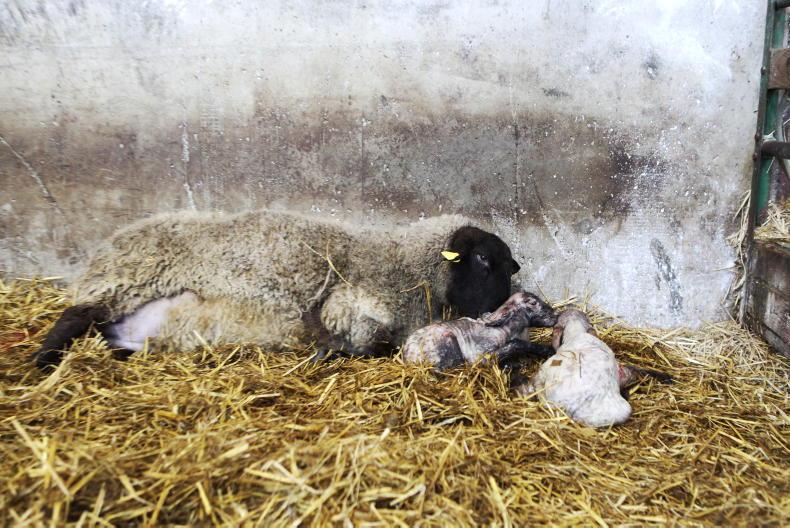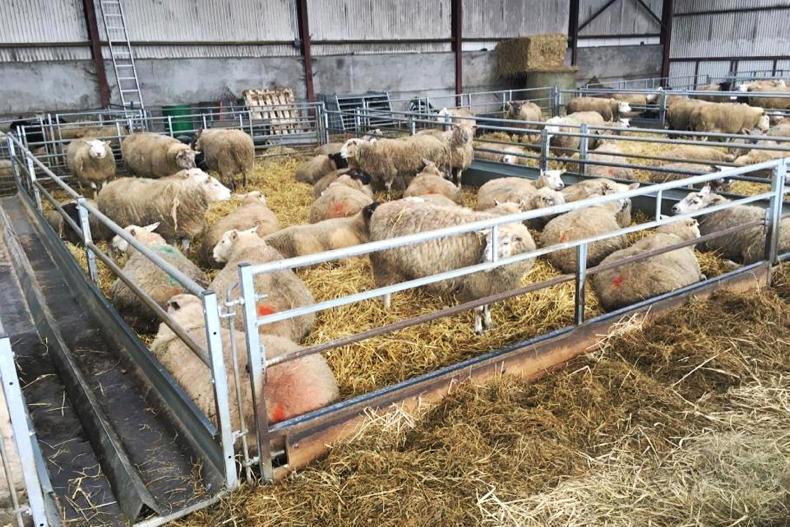Farmers are reporting an increase in the incidence of issues such as prolapse and sporadic abortions, which generally rear their head in the final weeks of gestation.
Some of the prolapse issues are related to ewes being in excellent body condition.
Having ewes in good body condition is positive from the perspective of ewes being able to utilise body condition, if required, to meet any nutritional deficit in early lactation, but it is also capable of causing significant issues if ewes are in excessive condition.
At this stage of gestation, there is nothing that can really be done about condition, and management therefore will centre on having all other management tasks catered for, so that there are not any other underlying factors contributing.
On the prolapse front, there are two problems being reported – incidences of normal cases of vaginal prolapse as the uterus expands, as well as the more serious condition of uterine prolapse.
Feeding management
A big factor in overcoming an increase in cases related to body condition is the type of diet offered and feed management. Feeding a high fibre diet or poor-quality forage will reduce the rate of digestion and can be linked to a higher incidence rate. Ensuring that high-energy ingredients are used in concentrate formulation and high-fibre feeds are fed in a restricted manner can also help, but be careful when adopting the latter to ensure that feed space is sufficient to allow all animals to eat with ease.
Significant changes in feeding routine should be avoided. For example, if feeding is delayed and ewes are hungry, they can gorge themselves on food when offered, which will increase competition for abdominal space. Hungry ewes fighting for feed space also face a higher risk of getting injured, which in turn increases the risk of abortions.
A big factor in overcoming an increase in cases related to body condition is the type of diet offered and feed management
While not always possible due to labour constraints, some flocks dealing with a high incidence in multiple births find that splitting concentrate supplementation from twice to three times daily in the final stages of gestation will help. Others with average-to-poor quality silage on hand find that cutting the level of silage offered and offering top-quality hay or straw where available, as well as increasing the concentrate feed level to keep energy intake constant, works well.
Another solution that works for some flocks is letting triplet and quad-bearing ewes out to grass. Grass will move through the animal quicker, cutting down on the need for supplementary feeding, while many vets suggest that exercise also helps in late pregnancy. This, of course, is not always practical with big numbers, but it may be an option for small numbers turned out by day to an adjoining paddock.
Related causes
It is also worth noting that the incidence of prolapse can also be influenced by numerous factors other than body condition and feeding, with a higher incidence rate normally seen in high prolificacy flocks.
Lameness in a flock can also trigger more cases, with ewes lying down for long periods, which puts increased pressure on vaginal muscles. The same can be said of ewes grazing on steep inclines, with ewes tending to lie in an uphill position meaning there is greater pressure on muscles. There is also some train of thought that genetics could play a role.

Administering an anti-inflammatory or pain killer may also be required to ease straining and forcing if issues persist post-delivery of lambs.
Treatment
The preferred treatment route for vaginal prolapse depends on the severity of the prolapse. For mild cases, applying a harness or using a rope to apply support similar to a harness will generally suffice. Where there is significant expulsion, then suturing will generally be required.
Administering an anti-inflammatory or pain killer may also be required to ease straining and forcing. In serious cases, it is generally also advisable to administer either a long-acting antibiotic or a three-to-five day treatment programme to prevent secondary bacterial infection.
The risk of secondary infection will be heavily dependent on hygiene in the surrounding environment and the level of care taken when re-inserting prolapsed material. The prolapsed material should be cleaned and where required, washed with warm water before re-inserting.
Uterine prolapse
Vaginal prolapse is the most common type of prolapse, but uterine prolapse can also occur in the final 10 days to two weeks of pregnancy. This can also occur post-lambing and is generally triggered by a difficult birth.
Suturing will be the only option in the case of a uterine prolapse, with a decision on treatment or euthanasia based on the expulsion of material additional to the uterus. Veterinary treatment, where an anaesthetic can also be administered or a call on euthanasia can be made, is recommended. The prognosis of recovery is unfortunately low.
Greater care with prolapse and lambing
Ewes that have experienced prolapse issues will need much closer attention at lambing, as harnesses will need to be removed to allow lambing to take place, while sutures/stiches may also need to be released depending on how they have been applied and the severity of the prolapse.
Ewes that have experienced significant problems will also be much more likely to require assistance, with some often aborting lambs, and as such should be supervised closely once lambing commences.
Ewes also tend to go off their feed easier and should receive preferential treatment to ensure nutritional intake is not compromised.
For most ewes, the removal of pressure from lambs being born will prevent post-lambing issues. Research shows that ewes that experience minor prolapse issues this year will not automatically experience a repeat of problems in the following season. In some cases however, there is a carryover of problems into lactation, and in such cases, most farmers identify ewes for culling. Ewes that have prolapsed should at least be temporarily identified post-lambing so that their health status can be easily followed up on.
Farmers are reporting an increase in the incidence of issues such as prolapse and sporadic abortions, which generally rear their head in the final weeks of gestation.
Some of the prolapse issues are related to ewes being in excellent body condition.
Having ewes in good body condition is positive from the perspective of ewes being able to utilise body condition, if required, to meet any nutritional deficit in early lactation, but it is also capable of causing significant issues if ewes are in excessive condition.
At this stage of gestation, there is nothing that can really be done about condition, and management therefore will centre on having all other management tasks catered for, so that there are not any other underlying factors contributing.
On the prolapse front, there are two problems being reported – incidences of normal cases of vaginal prolapse as the uterus expands, as well as the more serious condition of uterine prolapse.
Feeding management
A big factor in overcoming an increase in cases related to body condition is the type of diet offered and feed management. Feeding a high fibre diet or poor-quality forage will reduce the rate of digestion and can be linked to a higher incidence rate. Ensuring that high-energy ingredients are used in concentrate formulation and high-fibre feeds are fed in a restricted manner can also help, but be careful when adopting the latter to ensure that feed space is sufficient to allow all animals to eat with ease.
Significant changes in feeding routine should be avoided. For example, if feeding is delayed and ewes are hungry, they can gorge themselves on food when offered, which will increase competition for abdominal space. Hungry ewes fighting for feed space also face a higher risk of getting injured, which in turn increases the risk of abortions.
A big factor in overcoming an increase in cases related to body condition is the type of diet offered and feed management
While not always possible due to labour constraints, some flocks dealing with a high incidence in multiple births find that splitting concentrate supplementation from twice to three times daily in the final stages of gestation will help. Others with average-to-poor quality silage on hand find that cutting the level of silage offered and offering top-quality hay or straw where available, as well as increasing the concentrate feed level to keep energy intake constant, works well.
Another solution that works for some flocks is letting triplet and quad-bearing ewes out to grass. Grass will move through the animal quicker, cutting down on the need for supplementary feeding, while many vets suggest that exercise also helps in late pregnancy. This, of course, is not always practical with big numbers, but it may be an option for small numbers turned out by day to an adjoining paddock.
Related causes
It is also worth noting that the incidence of prolapse can also be influenced by numerous factors other than body condition and feeding, with a higher incidence rate normally seen in high prolificacy flocks.
Lameness in a flock can also trigger more cases, with ewes lying down for long periods, which puts increased pressure on vaginal muscles. The same can be said of ewes grazing on steep inclines, with ewes tending to lie in an uphill position meaning there is greater pressure on muscles. There is also some train of thought that genetics could play a role.

Administering an anti-inflammatory or pain killer may also be required to ease straining and forcing if issues persist post-delivery of lambs.
Treatment
The preferred treatment route for vaginal prolapse depends on the severity of the prolapse. For mild cases, applying a harness or using a rope to apply support similar to a harness will generally suffice. Where there is significant expulsion, then suturing will generally be required.
Administering an anti-inflammatory or pain killer may also be required to ease straining and forcing. In serious cases, it is generally also advisable to administer either a long-acting antibiotic or a three-to-five day treatment programme to prevent secondary bacterial infection.
The risk of secondary infection will be heavily dependent on hygiene in the surrounding environment and the level of care taken when re-inserting prolapsed material. The prolapsed material should be cleaned and where required, washed with warm water before re-inserting.
Uterine prolapse
Vaginal prolapse is the most common type of prolapse, but uterine prolapse can also occur in the final 10 days to two weeks of pregnancy. This can also occur post-lambing and is generally triggered by a difficult birth.
Suturing will be the only option in the case of a uterine prolapse, with a decision on treatment or euthanasia based on the expulsion of material additional to the uterus. Veterinary treatment, where an anaesthetic can also be administered or a call on euthanasia can be made, is recommended. The prognosis of recovery is unfortunately low.
Greater care with prolapse and lambing
Ewes that have experienced prolapse issues will need much closer attention at lambing, as harnesses will need to be removed to allow lambing to take place, while sutures/stiches may also need to be released depending on how they have been applied and the severity of the prolapse.
Ewes that have experienced significant problems will also be much more likely to require assistance, with some often aborting lambs, and as such should be supervised closely once lambing commences.
Ewes also tend to go off their feed easier and should receive preferential treatment to ensure nutritional intake is not compromised.
For most ewes, the removal of pressure from lambs being born will prevent post-lambing issues. Research shows that ewes that experience minor prolapse issues this year will not automatically experience a repeat of problems in the following season. In some cases however, there is a carryover of problems into lactation, and in such cases, most farmers identify ewes for culling. Ewes that have prolapsed should at least be temporarily identified post-lambing so that their health status can be easily followed up on.







 This is a subscriber-only article
This is a subscriber-only article











SHARING OPTIONS: